Justin Long Walking With Dinosaurs
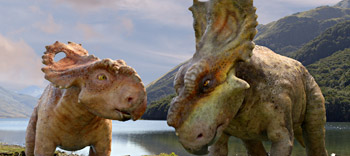
Justin Long Walking With Dinosaurs
Cast: John Leguizamo, Justin Long, Karl Urban
Directors: Barry Cook and Neil Nightingale
Genre: 3D Family Adventure
Rated: PG
Running Time: 87 minutes
Synopsis: For the first time in movie history, audiences will truly see and feel what it was like when dinosaurs ruled the Earth. Walking With Dinosaurs is the ultimate immersive, big-screen adventure for families. You'll meet dinosaurs more real than you've ever seen as you embark on a thrilling prehistoric journey, where Patchi, an underdog dino, triumphs against all odds to become a hero for the ages.
Patchi's heroics and antics resonate in any era, but he is also a product of his times and stomping grounds – the latter part of the Cretaceous Period, about 70 million years ago in a land we now call Alaska.
Walking With Dinosaurs
Release Date: January 1st, 2014
A Story And Hero 70 Million Years In The Making
Walking With Dinosaurs presented a unique creative challenge to its filmmakers, who had to project themselves back in time – 70 million years – to what is now the U.S. state of Alaska, in the Late Cretaceous Period. Then, they had to imagine the myriad adventures a lovable young dinosaur might encounter on an odyssey unlike any other.
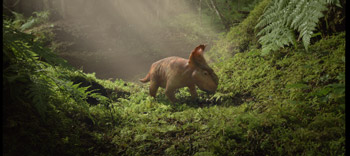 'Walking With Dinosaurs is a story about a dinosaur's life and adventures, and we've gone to the ends of the world to film it!" says director Barry Cook, whose credits include the animated feature Mulan, co-directing the animated feature Arthur Christmas and working in a variety of key creative capacities on Aladdin, Beauty and the Beast, The Little Mermaid and TRON. Now, with Walking With Dinosaurs, Barry Cook inhabits a world far away and long, long ago – and makes it come spectacularly alive.
'Walking With Dinosaurs is a story about a dinosaur's life and adventures, and we've gone to the ends of the world to film it!" says director Barry Cook, whose credits include the animated feature Mulan, co-directing the animated feature Arthur Christmas and working in a variety of key creative capacities on Aladdin, Beauty and the Beast, The Little Mermaid and TRON. Now, with Walking With Dinosaurs, Barry Cook inhabits a world far away and long, long ago – and makes it come spectacularly alive.
Also taking on directing duties is Neil Nightingale, a filmmaker admired around the world for his ability to capture nature's wonders in ways you've never experienced. 'Life's fundamentals have not really changed since the time of the dinosaurs," says Neil Nightingale, who is Creative Director at BBC Earth, where he spearheads the development of new forms of commercial content. 'Thankfully, we don't face perilous pursuit by hungry gorgosaurs, but audiences can identify with Patchi's quest for survival. We meet him as a hatchling and watch him learn to navigate his environment and face the primary challenges of finding enough to eat, evading predators and rising above his rivals in order to win a mate. These are things we can all recognize and empathize with. Audiences will really get behind Patchi and root for this underdog hero to triumph."
Walking With Dinosaurs points to our continuing fascination, if not obsession with creatures that have been extinct for millions of years. The T. rex and the Gorgosaurus are among the most fearsome predators to have ever walked the Earth, but kids (of all ages) can't get enough of them. Dinosaurs spark our imaginations as much as any fictional creation does.
'Kids love dinosaurs, and they're going to love Walking With Dinosaurs because it feels so real, has lots of humour and fun," says John Leguizamo, who voices Alex, a prehistoric parrot who is Patchi's best pal. 'Plus, they'll love the camaraderie between Patchi and Alex."
Dinosaurs combine the best of two worlds: they're scary, but because dinos haven't been around for millions of years, they're non-threatening. Neil Nightingale believes our enduring obsession with them is here to stay. 'Dinosaurs are the most amazing creatures to have ever existed on our planet. In four and a half billion years of Earth's existence, there have been no creatures that are more dramatic or terrifying. Dinosaurs fascinate us because they represent a sort of safe danger. You can be scared of them but not too scared because they are long gone. They're not going to come out from under the bed or pounce on you in the dark! And it is not just dinosaurs we are talking about; it is The Age of Dinosaurs. It is amazing to know that the world we now live in, the skies above us and the stars we see were once their realm– incredible animals now lost to prehistoric history."
'In bringing Walking With Dinosaurs to the big screen, we wanted to transport audiences back to a real world, to meet dinosaurs that truly existed and to immerse audiences in that world," Neil Nightingale continues. 'For a big motion picture experience it's also vital to have a strong and emotionally engaging story. So we used what we know about Late Cretaceous Alaskan dinosaurs as inspiration for a fictional, character-driven story we knew would entertain families."
Screenwriter John Collee's (Master and Commander: The Far Side of the World) tale introduces us to the movies' newest hero: Patchi. Ever curious, always brave and unfailingly optimistic, Patchi pretty much has us at 'hello" – when we meet him as a hatchling, and then share his adventures as he grows to adulthood.
Patchi hails from a family and tribe of Pachyrhinosaurus (from the Greek for 'thick-nosed lizard") dinosaurs. He is far from being the biggest or toughest guy in the herd, so he must use his wits and his heart to compete for food with his larger brothers and sisters, particularly Scowler, the alpha male of the group who has ambitions to succeed his father as leader of the herd.
'Patchi must survive an adventure that calls on him to use all of his inner strength, tenacity and courage to become a hero," elaborates director Barry Cook. 'In a world that demands physical strength, Patchi's physiognomy makes him the quintessential long shot that everyone will root for."
The character's creators gave him important qualities that add up to far more than brute force. 'Patchi has a unique personality trait in that he seems to have the capacity to -see the big picture' and consider how his actions affect not only himself but those around him. He's also endearing through his curiosity and drive to never give up," Barry Cook adds.
'Patchi is a diminutive outcast who faces all changes by believing in himself and trusting his inner courage," says Neil Nightingale. 'At its heart, Walking With Dinosaurs is a classic coming of age tale. You have two rival brothers, a love story and an epic journey that presents a series of hurdles for Patchi to overcome."
Patchi's ability to think outside of the nest is evident even as a hatchling, when he wanders from his home to explore his surroundings. These early forays can have wildly unexpected consequences, like when Patchi is snatched by a hungry predator, which leaves him with his defining physical trait – a bite-hole in his frill.
According to actor Justin Long (Live Free or Die Hard), who voices the role, Patchi has 'an insatiable curiosity, as many runts do. It does get him into trouble, but in the long run it helps him evolve and become the leader he was meant to be."
The puny Pachyrhinosaurus' intrepid spirit captures the attention of Alex, a prehistoric bird whose default traits are humor and ebullience. Alex is fascinated by Patchi and his adventures, and isn't shy about unexpectedly showing up on the scene and nudging Patchi in the right direction. 'He's Patchi's friend, guide, conscience and mentor," says Justin Long.
John Leguizamo, having voiced the role of the silly sloth Sid in the blockbuster Ice Age films, embraced the new challenges that came with finding a voice for Alex. 'Alex is a kind of precursor to a parrot, so I adopted a Spanish accent for Alex because most parrots come from Latin American countries," he explains. 'What was most difficult was finding the right pitch, because Alex is a small bird, but he's also the story's narrator. So he also had to sound paternal and patriarchal."
Like many strong friendships, Patchi's and Alex's is symbiotic. 'The Pachyrhinosaurus herd attracts a lot of insects, which Alex regularly snacks on," says Long. Adds John Leguizamo: 'Patchi's basically a four-legged buffet for Alex."
Unlike Alex, Patchi's older brother Scowler is less than helpful in showing Patchi the path to survival and heroism. Big, strong and single-minded, Scowler will take on any challenge – or challenger – to lead the herd. He is usually OK with his younger bro, but Scowler's goals often lead to some intense sibling rivalry.
'Scowler teases Patchi, taunts him, and picks on him," says Justin Long. 'It's classic sibling rivalry. Patchi's always trying to impress Scowler, but Scowler's not easily impressed."
Patchi's heart and fearlessness are more than enough to match Scowler's size and strength. But Patchi must summon a different kind of courage to approach a pretty (for a Pachyrhinosaurus, anyway) female named Juniper. Juniper shares Patchi's sense of adventure, as well as his bravery and resilience. When she's separated from both her family and the herd, Juniper develops a real connection with Patchi, even though she can't always show it.
If love is in the air then so is the continued presence of danger, mostly in the formidable form of a cunning and relentless Gorgosauraus named Gorgon. Always on the lookout for his next meal, Gorgon is like a turbo-charged T. rex, and uses precise tactics and strategies to track his prey. 'Gorgon is the baddest of the bad," says Justin Long. He's the Lucifer of the dinosaur world."
While the filmmakers hold special affection for their young hero, a few confess to a special appreciation for the film's villain. 'I loved Gorgon; I could make an entire movie about this guy!" says Animation Director Marco Marenghi, whose credits include Tim Burton's Alice in Wonderland, Steven Spielberg's Minority Report and the box-office hit I Am Legend.
Also playing a key role in Patchi's journeys is his father, Bulldust, the strong and respected leader of the Pachyrhinosaurus herd. While leading his family in the annual migration, Bulldust, along with Scowler and Patchi, are separated from the others in a forest fire. Trapped by a Gorgosaurus, Bulldust sacrifices himself to save his sons. Patchi's Mom also perishes in the fire.
Left alone after making it through the inferno, the two brothers must fend for themselves. Their ominous situation heightens their rivalry, and the tension continues to escalate as Patchi and Scowler grow into powerful young adult males.
The herd's migration leads the brothers and Juniper to their greatest battle, where Patchi summons his inner courage and strength to become the leader he was born to be.
Cutting-Edge Tools For A Prehistoric Tale
The vast and colourful world of Walking With Dinosaurs provides the perfect backdrop for a thrilling family-themed story with vivid and fun characters. Moreover, no other motion picture has created dinosaurs that look this real and that interact with their environment in such an authentic way. Bringing it all to life are the latest dinosaur research and discoveries, realistic designs created in collaboration with paleontologists, cutting edge visual effects delivered by the award-winning company Animal Logic, and 3D wizardry from Cameron Pace Group (CPG). CPG's groundbreaking work includes Avatar, captured, like Walking With Dinosaurs, using the Fusion Camera System developed by company principals James Cameron and Vince Pace.
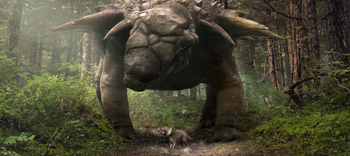 This collective talent has created a layered world rich with incredible sights and astonishing characters.
This collective talent has created a layered world rich with incredible sights and astonishing characters.
The filmmakers tapped a century of collective research to ensure authenticity in locations and dinosaur renderings. Director Barry Cook notes that, 'Although dinosaurs roamed the Earth millions of years ago, they are relatively new to the human experience. Only recently have we been able to see these creatures brought to life on film. We've learned more about dinosaurs in the past 100 years than in the rest of combined human history."
Marco Marenghi, Head of Animation at Animal Logic, adds: 'As a movie, Walking With Dinosaurs is designed to entertain but it is driven by many factual discoveries and whenever possible, it is as accurate as we could make it."
In the course of their exhaustive research, the filmmakers learned about many dinosaur species that lived in Arctic Alaska and Canada 70 million years ago. Those findings provided a wealth of types and characters for the film. Moreover, Cretaceous Alaska creates a stunning backdrop because it had a much milder climate than it does today, closer to Seattle's or Scotland's, with distinct summers and winters. This presented an exciting new world for the filmmakers to bring to life.
To achieve their goal of transporting audiences back in time, the filmmakers shot most of the environments on location, in the wilds of Alaska and New Zealand. 'The intention," says Neil Nightingale, 'was for Walking With Dinosaurs to look as though a real wildlife cameraman had gone back in time to capture the footage. So we found locations that would replicate, as closely as we could in the modern world, Arctic Alaska in the Cretaceous Period."
Bringing a new dimension to this world is the 3D Fusion Camera System – the world's most advanced stereoscopic system. Key crew members from the Cameron Pace Group team, including director of photography John Brooks, lent their talents to the shoot, which yielded fantastic real-life backdrops that merged seamlessly with the computer generated dinosaur characters to create a unified whole.
'We knew the project was ambitious so wanted to partner with the industry leader in 3D technology," explains producer Mike Devlin, CEO of Evergreen Studios. 'Cameron Pace is highly respected for its technology innovation, R&D, engineering and manufacturing. They are truly creative artists and have over eleven patents such as the Fusion 3D camera and workflow system that was used on this film. Their rigs and equipment for the 3D settings of the cameras allowed for an immersive filming environment. They have the highest standards of quality, and it was an honour to work with them."
According to Vince Pace, CPG's approach to 3D was a key element in bringing the film's you-are-there qualities to life. 'We use a specific approach to 3D. So as a shot gets more intimate or more distant, we're adjusting those settings of the two cameras on a dynamic basis. It's an approach that has worked very well for us; we let the shot breathe in 3D and really tell its own story based on the look and feel of 3D," he explains.
When asked about a favourite scene employing these cutting-edge 3D systems, Vince Pace instead points to their big-picture benefits. 'I think the most important thing is almost forgetting the movie is in 3D and instead getting the sense of how real it feels. That's the biggest payoff for me. The 3D in Walking With Dinosaurs makes you feel you're traveling back in time and that this world and characters all blend together
I have an eleven-year-old and a nine-year-old and I can't wait for them to see it," Vince Pace continues. 'I know the film is going to resonate with kids and with families."
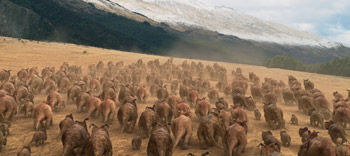 Director of photography John Brooks embraced the challenges of bringing audiences into this incredible world: 'It's all about presenting environments that feel like you're a part of them. We've done that with every shot," he notes.
Director of photography John Brooks embraced the challenges of bringing audiences into this incredible world: 'It's all about presenting environments that feel like you're a part of them. We've done that with every shot," he notes.
While Pace is reluctant to pinpoint a favourite sequence that highlights this 3D magic, John Brooks cites the enormous fire that threatens Patchi and the herd as one of the most intricate and rewarding. He explains: 'If you watch fire, even in your own fireplace, you'll see it has a certain volume and three dimensional character. So we shot tests to see where we wanted to put the volume on film, and we found the necessary roundness the fire needed so it didn't pull apart and seem fake. The final version of the fire sequence makes you feel like you're right there with Patchi. You will feel the heat!"
For Barry Cook, filming on location in 3D for the first time in his impressive career was a revelation and not just in the film's sweeping action scenes. 'I've learned ways to use the power of 3D to enhance certain moments in the story," he explains. 'One of the most dynamic 3D moments in the film is when Patchi is at his very lowest, emotionally. At first, the idea of using a very -deep canvas' for this scene seemed counter-intuitive. But by doing so it tends to draw the audience in to experience a real empathy for Patchi."
'Walking With Dinosaurs had to be bigger and more immersive than anything that had gone before," Barry Cook adds. 'The dinosaurs you see are really believable and the level of action, drama and emotion is intense. With the world of CGI moving on we've created a -you-are-there' experience. By seeing the movie on the big screen you are transported to that time, the story envelops you, and you're amongst the dinosaurs, sharing their adventures."
The filmmakers digitally married the 3D live action backgrounds to the computer generated characters to create an impressive photorealistic effect. This was accomplished by scanning the locations with LIDAR (Light Detection and Ranging). LIDAR uses light pulses to find distance information about environmental objects, which provided the filmmakers with a high resolution CG model. LIDAR technology has been used for years in CG shots to capture backgrounds, but never before for nearly an entire movie, as it was with Walking With Dinosaurs.
'You will be able to see that this process brings an entirely new level of realism in contact dynamics as the characters interact with each other and their world," says Mike Devlin.
Only two scenes employed CGI instead of LIDAR and were set in an icy lake where two characters battle. 'We wanted the dinosaurs to interact with the ground, so we created ice in a computer," explains Neil Nightingale. 'This was the most effective way for us to get our dinosaurs to interact and fight, ensuring their fall through the ice looked and felt realistic in keeping up with the dramatic pace of the movie. The way we can create realistic worlds using CGI is incredibly exciting, allowing us to tell stories that just a few years ago would have been impossible."
The dinosaur characters are remarkable for their incredible detail. Audiences will see every scale and feather on the creatures. Cutting edge and proprietary software created a CGI muscle system based on painstaking research – all of which ensured that the film's dinosaur's move as their real-life counterparts did 70 million years ago.
The award-winning visual effects house Animal Logic created the film's digital dino magic. The company's groundbreaking CGI work in animal skin, collision dynamics, particle systems and feathers had long impressed the teams at Evergreen Studios and BBC Earth. Says Mike Devlin: 'Animal Logic's software innovations helped create the most realistic creatures ever projected. Their contribution to Walking With Dinosaurs is instantly recognisable in the remarkable realism of these prehistoric characters."
Marenghi, head of Animation, credits two rendering breakthroughs as being 'game-changing." 'The two big ones," he elaborates, 'were the skin/scale system and the excellent muscle system our team of character setup artists created for us. This really told us a lot about how these amazing creatures were built, moved and interacted."
The visual effects department, headed by VFX supervisor Will Reichelt, also created footprints, splashes, dust and a myriad of other generated effects, which make us believe that a dinosaur is inhabiting a given setting. 'We made sure the production received all the necessary information for integrating the dinosaurs into the live action plates captured on location," says Will Reichelt
Before Animal Logic created its digital wonders, dinosaur designer and paleo-artist David Krentz worked on early dinosaur renderings using a sophisticated computer-modeling and sculpting program called ZBrush. 'I'm a traditional clay sculptor, so ZBrush fit me well," says David Krentz, who credits the 1933 classic King Kong with inspiring his interest in dinosaurs and natural science. 'You squish, pull, rake and slap on digital clay until you get a nice base model."
But creating characters, notes David Krentz, transcends physical modelling. 'It's always about telling a story, so I have to know what the characters are about before I even begin to draw or work up a CG model," he explains. Making a -Scary Tyrannosaurus' or -Hero Herbivore' is just not enough. Why are they scary and why are they a hero? You have to forget all about the bones, at first, and concentrate on traits that will underscore the character's life journey. Things like attitude, gestures, and the look in their eyes are important."
Beginnings and Wrap-Up
Walking With Dinosaurs represents the work of some of the motion picture world's most talented filmmakers, technicians and artists. But there would be no big screen event without the groundbreaking television series that preceded it fourteen years ago. The series, like the movie, used advanced technology to take viewers into the world of the dinosaurs.
Walking with Dinosaurs' depiction of dinosaurs as though they were being filmed in the wild was a revolutionary move away from traditional dinosaur-themed documentaries. It forever changed the way we perceived the fearsome and larger-than-life creatures.
By 2010, advances in CGI and 3D technologies created a new opportunity to reinvent the franchise in an even more ambitious fashion – as an epic motion picture adventure. Inspired by the latest scientific discoveries, the Walking With Dinosaurs movie ushers audiences – in ways never before possible – into exotic but real environments populated by characters rich with emotion and personality.
The two filmmakers at the helm of this incarnation of a beloved franchise have high hopes for Walking With Dinosaurs. 'It's all about trying to tell a good story and bringing characters to life in a way that audiences can relate to and connect with emotionally," says Barry Cook.
Adds Neil Nightingale: 'We want moviegoers to love the characters and love being transported back in time and immersed in a world that existed tens of millions of years ago."
Walking With Dinosaurs opens in theaters everywhere December 20, 2013.
The Science That Inspired Walking With Dinosaurs
Since the original Walking with Dinosaurs television series aired, a wealth of new dinosaur finds has taken our understanding of these amazing creatures to new levels. Dinosaur remains have been unearthed on every continent, revealing that the group thrived around the globe during the Mesozoic era, which covers three important geologic periods: the Triassic, the Jurassic and the Cretaceous. The 3D movie is set towards the end of the Cretaceous Period.
Recent discoveries that inspired Walking With Dinosaurs include:
The World of Walking With Dinosaurs
Herds
Huge 'bone-beds" found in Alaska and Canada over the past two decades have brought to our attention the remains of hundreds of similar animals, old and young, all jumbled together. This suggests a mass death caused by a catastrophe such as a flash-flood. (The movie presents a scenario in which ice breaks over a frozen lake). Most importantly for our story, these finds show that vast herds of large herbivores, including Pachyrhinosaurus and Edmontosaurus, roamed Late Cretaceous Alaska.
Migration
Large herds cannot remain in one location without destroying the vegetation that serves as their food source. So it is likely that some dinosaurs migrated great distances annually in search of food and more favorable environmental conditions – just as caribou do today.
Family Behavior
We meet Patchi in the nest being cared for by his mother and watched over by his formidable father Bulldust. All dinosaurs laid eggs. Some fossils suggest that certain dinosaur species looked after their young, including fossils of dinosaurs tending their eggs and fossils of nestlings in and around dinosaur nests.
Family group fossils – assemblages of fossil bones and footprints show that youngsters and adults of many dinosaur species travelled in groups, suggesting that adults and young remained together even after leaving the nesting area.
The cast of Walking With Dinosaurs
The diverse cast of characters you meet in the movie is based on the range of animals found at the various fossil sites in Alaska and Canada, particularly from Prince Creek, Horseshoe Canyon, Bear Paw, Wapiti, and Dinosaur Provincial Park.
Ecology
The Denali excavations have built up a picture of an entire Late Cretaceous ecology, including the primary dinosaur species, mammals, birds (including shore birds, mud-peckers and waders), amphibians and insects. Together these finds, and other clues unearthed in Alaska and elsewhere, enabled us to reconstruct the world that served as home for these amazing dinosaurs.
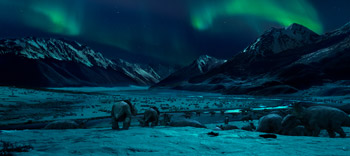 Life-like Dinosaurs Brought to the Big Screen:
Life-like Dinosaurs Brought to the Big Screen:
Controversy settled
When the Walking with Dinosaurs TV series was broadcast the idea that birds were descended from dinosaurs was still a matter of hot debate. Now there is no doubt. Many new finds of bird-like dinosaurs and dinosaur-like birds, particularly those emerging from spectacular sites in China, have established the direct link between the theropod dinosaurs (like Gorgosaurus) and the lineage of birds.
So, contrary to popular belief, the dinosaurs did not go extinct 66 million years ago. They're still around us – as birds. In fact, with about 10,000 living bird species, there are more kinds of dinosaur descendants around on Earth today than mammals.
Skin and Feathers
We're used to seeing depictions of dinosaurs as giant reptiles – the word dinosaur means 'terrible lizard" – and we've grown up imagining them as such. However many fossils have remains of soft tissue, skin impressions and impressions of feathers (particularly notable finds are those of feathered dinosaurs in China and Mongolia). It is now clear that many dinosaurs (and very likely all of the theropods) were feathered, particularly the young of the species, who might have lost their downy feathers as they aged.
Colour
By the Late Cretaceous Period, flowering plants had evolved, suggesting a world rich with color. It is likely that dinosaurs would have had color vision in order to flourish. Following from this, it is likely they were colored themselves.
Very special fossils have been found in China and Mongolia, which show us the colors of dinosaurs. In particular, melanosomes (pigmentation structures within animal cells) have been preserved and from the shapes of these structures we can ascertain the types of colors and patterns these animals had. Anchiornis huxleyi was white, black and russet red. Sinosauropteryx was stripy ginger! Furthermore, dinosaurs like Microraptor have been found to have iridescent feathers like a number of birds today.
http://www.wired.com/wiredscience/2010/02/dinosaur-fossil-reveals-true-feather-colors/
The discovery of a mummified Hadrosaur, including some of its soft tissue, included skin texture, showing variation typical of striped color.
http://news.bbc.co.uk/1/hi/sci/tech/7124969.stm
New perception of Pterosaurs
Pterosaurs could move better on land than we once thought, and they could easily fly or glide long distances.
Adaptability
Dinosaurs have now been found on all continents across the prehistoric globe, including at both Poles with their long, harsh winters.
The Troodon you meet in Walking With Dinosaurs are based on those found in Alaska. They had large eyes and were much bigger than other Troodon species in other parts of the world. Their large eyes probably gave them an advantage in the dark Arctic winter, and enabled them to become one of the area's most successful predators. This inspired their role in the movie as a constant predatory threat.
Walking With Dinosaurs: Amazing Facts
Your nose will be thankful you don't live in the Late Jurassic Period: A single Diplodocus fart would have produced enough gas to fill a hot air balloon.
Some members of a pterosaur group called the azhdarchids would have had jaws up to 2.5 meters long. Although they had no teeth, their jaw size is more than enough to swallow a child whole.
Some azhdarchid pterosaurs were the size of a small plane.
Coprolites (fossilised poop) belonging to Tyrannosaurus rex (a relative of Gorgosaurus) have been found measuring 2 liters (3.5 pints) in volume – the size of a big bottle of your favorite fizzy drink.
Some of the more out-there theories explaining the dinosaurs' extinction include that they all became blind due to cataracts caused by the hot, sunny climate and a plague of caterpillars that ate all the vegetation.
Another Late Jurassic dinosaur, Stegosaurus, had a brain the size of a kitten's (even though its body weighed more than 2700 kittens).
Ankylosaurs were plant-eaters. They probably consumed the equivalent of over 700 carrots per day, in the form of low growing plants like ferns, cycads and perhaps even flowering plants, which were diversifying during the Cretaceous period.
The film's fine-feathered hero Alex belongs to a group of toothed birds that lived alongside the dinosaurs. The birds we know today have lost their teeth. However, scientists have successfully made chickens grow teeth just like Alex's in laboratory experiments. This suggests the genes that code for teeth are still hidden away in the DNA of living birds!
Chirostenotes had no teeth. Instead it had a beak and an elongated second finger, which some scientists believe was used to probe crevices for grubs and armored amphibians.
Some scientists once believed that Edmontosaurus could hop like a kangaroo. The discovery of more complete skeletons shows this view to be incorrect.
Scientists have identified a fossil of Edmontosaurus skin that is preserved so intricately that you can see a scar.
Gorgosaurus teeth were banana shaped but serrated like a carving knife – perfect for sawing into flesh.
Dinosaurs could grow brain tumors! One Gorgosaurus fossil has been uncovered with a spongy mass in its skull cavity. This would have made the animal a bit wobbly and accident prone when it was alive.
Scientists are uncertain why many theropod dinosaurs like Gorgosaurus had such short arms. Theories about how these arms were used range from plausible to silly, including:
Holding its probably-still-wiggling food still as it ate
In some kind of mating ritual
Use by juveniles when feeding (in young tyrannosaurs, the arms were more sizeable relative to the body than in adults)
To aid in balance, turning or agility
To prepare a nest - in effect, to make their bed
Turning their eggs
To help them right themselves in case they fell over
No use at all and were just slowly becoming lost over time through evolution
Walking With Dinosaurs Filming Locations
ALASKA:
Anchorage
Girdwood
Kenai
Ninilchik
Homer
Glenorchy
Te Anau
Mavora Lakes
Ahuriri River (outside Omarama)
Eastwood & Westwood Rivers (outside Kingston Station)
Kawarau River
Walking With Dinosaurs
Release Date: January 1st, 2014
MORE





